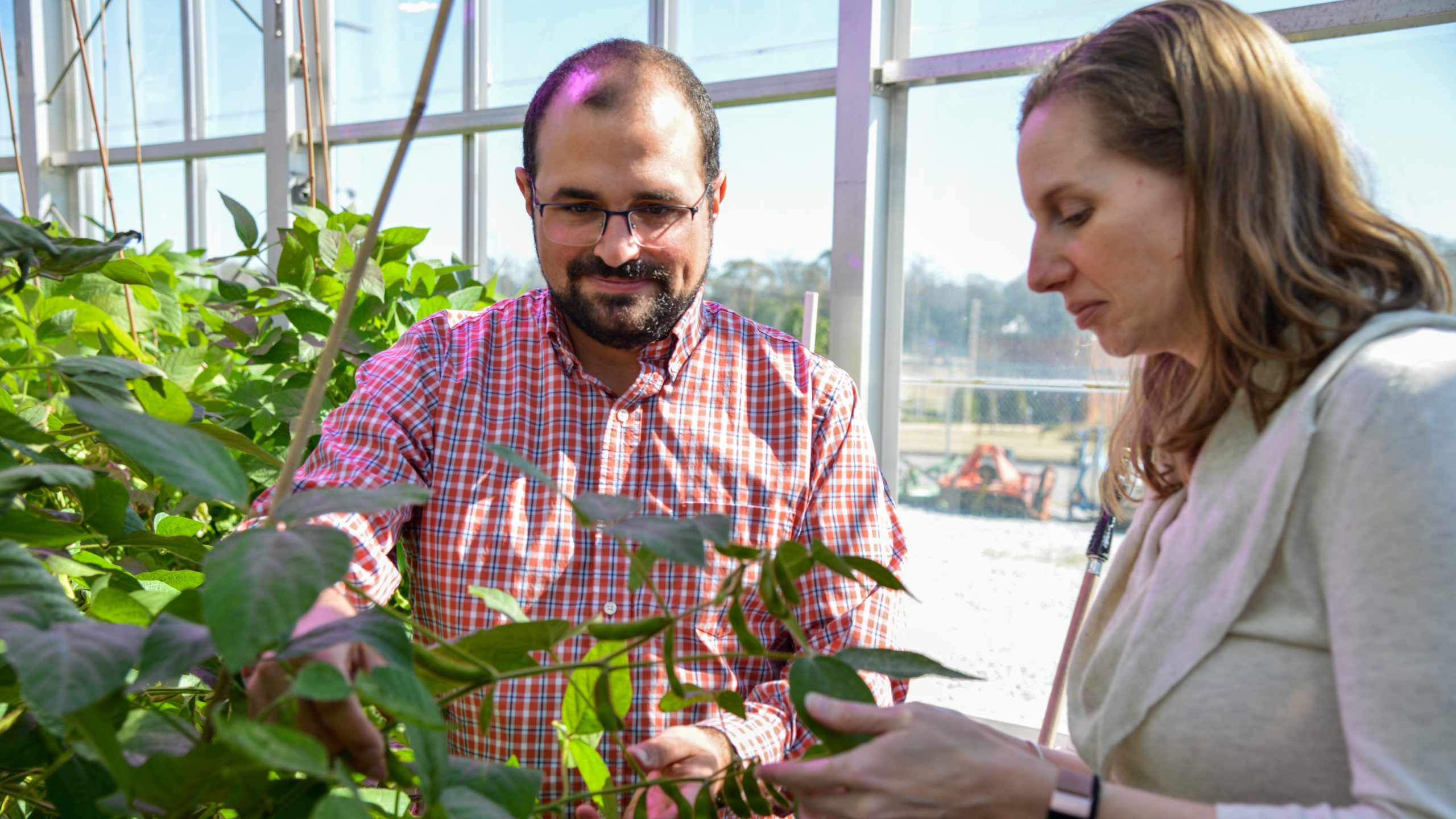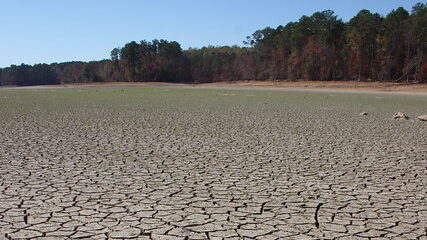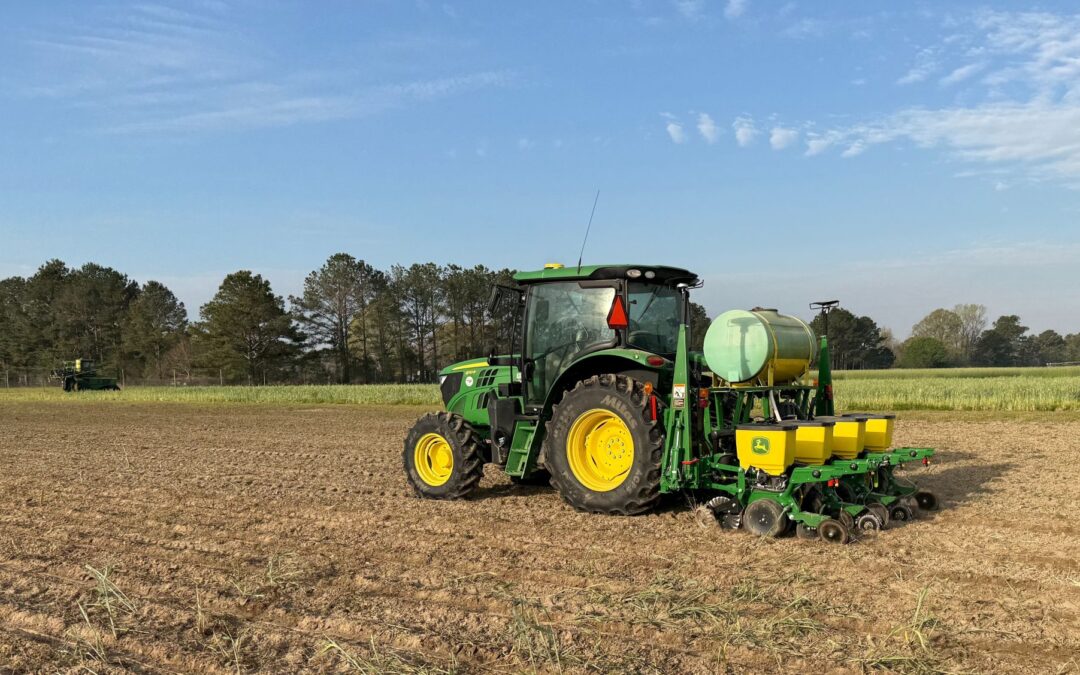By Jacqueline Kochak
Stroll through the humid main corridor at Auburn University’s Plant Science Research Center and you’ll notice potted trees bearing clusters of green bananas and small shrubs with pineapples nestled in the center. Those are for the school children who frequently visit the center.
Go a little further and you’ll come to a door marked “Disease Prevention Area.” Beyond that door you’ll find a greenhouse full of soybeans. Lots of soybeans. Some are short and some are taller. Some are bright green and some are yellowish. These differences you can see with your eyes are called “phenotypic variation.”
Growing these different soybean plants from germplasm supplied by the U.S. Department of Agriculture is the first step in learning why soybeans lose nutrients as levels of carbon dioxide in the air increase. Alvaro Sanz-Saez, a crop physiologist in the College of Agriculture, is one of two Auburn professors awarded a USDA grant of more than $635,000 to study the question. Courtney Leisner, principal investigator, is from the College of Science and Mathematics and her field is genomics-enabled plant physiology.
During photosynthesis, plants take in carbon dioxide and water through stomata, tiny pores in their leaves and stems. Since the 1950s, carbon dioxide levels in the air have been increasing steadily, and a large body of previous research has documented the effects of elevated carbon dioxide on C3 plants (C3 refers to the form of photosynthesis the plant uses). C3 plants include some of the most important sources of nutritional calories in the world, plants such as rice, wheat, oats, cassava, peanuts — and soybeans.
Carbon dioxide is like food for plants, and when they get more food they grow more, creating additional “biomass.” That’s good news for producers, who can grow more in the same space. At the same time, the plants are less nutritious, with lower levels of vital mineral nutrients like iron and zinc. If C3 crops lack adequate mineral nutrients, that could lead to a kind of “hidden hunger” in parts of the world where meat is scarce and people rely on plants — particularly legumes like beans, peas and lentils — for adequate nutrition.
“This change in nutrient accumulation has been documented in many crops in many locations, in the greenhouse and in the field,” explained Sanz-Saez. “What we don’t know is why.”
Sanz-Saez and Leisner have both worked with soybeans, also a legume. They looked at the literature and found that some soybean cultivars show increased yield, some have increased zinc, and some have increased iron, among various differences. Since cultivars are plant varieties that humans have produced through selective breeding, they knew the differences they could see in different cultivars — their phenotypes — were the result of different genotypes, or combinations of genes.
“There’s a lot of variation in soybeans,” Leisner said. “We thought we could leverage that by comparing genotypic differences to phenotypic variation to dissect the underlying mechanism.”
There are many soybean cultivars available and plenty of genetic data available using freely available soybean lines. Sanz-Saez and Leisner reasoned that soybeans could provide a model for other C3 crops, particularly legumes, and this knowledge could translate directly into the development of more climate-resilient crops, since increasing carbon dioxide levels are associated with climate change.
They are now growing the initial crop of the eight cultivars obtained from the USDA germplasm in a growth chamber at the plant center. The cultivars are grown under controlled conditions so researchers will know that the phenotypic differences came from the plant’s genes, not from variations in water, temperature or soil. Carried about by Sanz-Saez, this process also allows for production of more seeds from each genotype, a process called “bulking.”
There are seven hypotheses about why plants have decreased mineral content when grown in a high CO2 environment, which are not mutually exclusive. One hypothesis, for example, is that as photosynthesis increases, the stomata close to protect the plants from water loss. The plants simply absorb less mineral nutrients from the air and soil through this decrease in transpiration. Another possibility is that as plants increase photosynthesis, the minerals are simply diluted by the increased sugar content (a product of photosynthesis) in the seeds.
They will be taking various physiological measurements and will do RNA sequencing on all of the cultivars. RNA is a complement to DNA; while DNA carries all an organism’s genes, expression of RNA provides the building blocks for proteins through translation to amino acids. RNA sequencing, an important tool in molecular biology, can give researchers a blueprint showing which genes are turned on and which are turned off, hinting at which genes are associated with specific plant traits.
All this data will be turned over to another co-PI, Ivan Baxter at the Donald Danforth Plant Science Center, an independent, nonprofit research institute in the St. Louis area. Using the data, a postdoctoral researcher in the Baxter group will build mathematical models of the underlying physiological mechanisms associated with elemental accumulation in soybean leaves and seeds. Outputs of these models will be validated in a field setting to determine the most likely mechanism for the decrease in nutrients.
The second two years of the three-year project will include work at the University of Illinois’ outdoor SoyFACE facility. FACE stands for Free Air Concentration Enrichment, and the facility offers field conditions with elevated CO2, thanks to a system of pipes constantly blowing carbon dioxide into the air. The lead investigator at SoyFACE is Lisa Ainsworth of the USDA Agricultural Research Service, who will be a collaborator on the project. She is part of the USDA’s Global Change and Photosynthesis Research Unit.
Sanz-Saez and Leisner met while working with Ainsworth at the facility. Leisner was a graduate student, while Sanz-Saez was serving a post-doctoral fellowship funded by the Spanish government. He is from the Basque region of Spain. Both say they were always interested in the effects of climate change.
Their project is titled “Dissecting the Physiological Mechanisms of Plant Nutrient Responses to Rising Atmospheric Carbon Dioxide Levels.”




